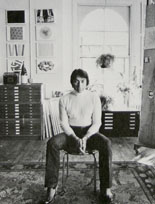
Lowell Nesbitt was a highly celebrated American artist associated with the Photo-realist and Pop Art movements of the 1960’s and 70’s. This work is a superb example of his most famous series, his gargantuan flower images such as irises, roses, and orchids, depicted in macro detail so that petals fill the canvas. The dramatic monumental scale denies connotations of fragile beauty, while the contextual isolation surpasses traditional social interpretations. Although Nesbitt was frequently grouped with the Photo-realist movement, his images are more cryptic, somewhat loosely painted and boldly abbreviated. His subjects ranged from articles of clothing, piles of shoes, nudes, caves, landscapes, animals, architectural details and structures in Manhattan, including Neoclassical facades of Soho's nineteenth century cast-iron buildings, bridges, Victorian staircases, and studio interiors. The subjects of many of the studio interior paintings were those of his colleagues, including Claes Oldenberg, Alex Katz, Robert Indiana, Helen Frankenthaler, and Andy Warhol. Unlike younger Photo-realist painters, Nesbitt always eschewed car parks, drive-ins, and other neo-Pop subject matter, preferring instead less time-bound, less sociological images; images that confront traditional realism as well as the viewers expectations.
Nesbitt was born in Baltimore, Maryland in 1933. He graduated from the Tyler School of Art at Temple University in Philadelphia in 1955, and then studied at the Royal College of Art in London. From 1963 he lived and worked in New York, and was credited as the first artist to produce a series of x-ray-inspired paintings. During this time he also created a series of electronic interior paintings and drawings based on the early IBM ENIAC and Univac computers. Beginning in the 1960’s he had a long-standing relationship with the Howard Wise Gallery in New York, a space devoted to art and new technology, a radical departure from the focus of other Manhattan galleries during that period. In 1976 he moved from a small studio on West 14th Street to an 18,000 square foot space that he renovated from a former police stable. This became his home and studio, which he referred to as “The Old Stable”, and provided a fitting backdrop for his larger then life artwork.
Nesbitt’s first solo museum exhibition was held at the Corcoran Gallery of Art in Washington, D.C. in 1964. He went on to exceed a hundred solo exhibitions in museums and galleries throughout the United States and abroad during his career. In 1980, the United States Postal Service issued a series of stamps of his “flower paintings”. He also served as the official artist for the space flights of Apollo 9 and Apollo 13.
His work is now included in the numerous museum collections worldwide, including Museum of Modern Art, New York; High Museum of Art, Atlanta, Georgia; Hirshhorn Museum, Washington D.C.; the Yale University Art Gallery; Worcester Museum, Massachusetts; National Collection of Fine Arts, Smithsonian Institution; Art Institute of Chicago; Fogg Art Museum; Dallas Museum of Fine Arts; Cleveland Museum of Art; National Gallery of Art, Wellington, New Zealand; Israel Museum, Jerusalem; Musée Nationale d’Art Moderne, Paris.